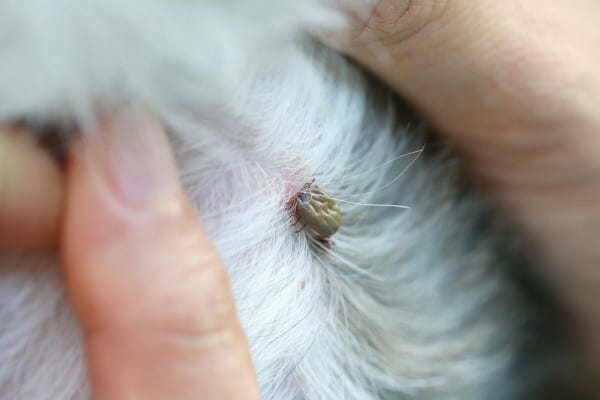Tick-borne diseases in dogs can cause an array of symptoms and a range of long-term effects. If your dog loves the outdoors, it’s crucial to know the 7 main tick-borne diseases in dogs and how to minimize your furry friend’s exposure. Integrative veterinarian Dr. Julie Buzby shows you how to enjoy the fresh air while keeping a wise eye on the silent—and oft-hidden—risks of tick-borne diseases.
Few sights warm your heart more than seeing your dog explore the outdoors, fetch a favorite toy, and roll around on the green grass simply enjoying life (if only we all could be as exuberant!).
And while outside play and exercise are beneficial for your dog, there may be an unseen danger lurking outside your back door—one too important for you to ignore: ticks and tick-borne diseases.
How can ticks make dogs sick?
Tick-borne diseases in dogs happen when an infected tick attaches itself to your dog, feeds on his blood, and then transmits the infection to your dog’s body. And it’s not just ticks—mosquitoes, fleas, sand flies, and black flies transmit over a dozen infections, known as vector-borne diseases. Both animals and humans are susceptible to vector-borne diseases.
I’ve seen and treated hundreds of dogs suffering from tick-borne disease. So it’s high on my list of concerns for my veterinary patients, particularly in the warm spring and hot summer months.
Causes of tick-borne diseases
Most tick-borne diseases are caused by bacteria. Typically, other animals (such as deer) are reservoirs for the diseases. The ticks feed off of reservoir animals, acquire the bacteria, and then spread the bacteria to their next hosts. The tick has to be attached for a period of time—up to 24 hours, depending on the disease—before the disease-causing bacteria is transmitted into the bloodstream.
Symptoms of these diseases don’t always start immediately following infection, so these conditions are on my mind even if I don’t find a tick on my canine patient when illness presents.

Symptoms of tick-borne disease in dogs
Unfortunately, diagnosis of tick-borne diseases can be a little tricky. One reason for this is that the symptoms of tick-borne illness can be pretty non-specific.
Signs of tick-borne disease in dogs can include:
- Fever
- Joint pain
- Lethargy
- Decreased appetite
- Enlarged lymph nodes (lymphadenopathy)
- Neurological problems
- Kidney problems
- Vomiting and/or diarrhea
Because signs can be so non-specific, it can be hard to diagnose tick-borne illness in dogs unless you’re looking for it.
Next, let’s take a deeper dive into tick-borne diseases and look at seven types, their symptoms, and tips for prevention.
7 most common tick-borne diseases in dogs
If you’re like most, Lyme is the first disease to come to mind, but there are other debilitating and potentially fatal tick-borne diseases. Let’s first discuss Lyme and then move on to the other less common diseases.
1. Lyme disease
Lyme disease is the most well-known and widespread tick disease in dogs—comprising nearly 82% of all vector-borne illnesses.
Blacklegged ticks, also known as deer ticks, spread Lyme disease.
Symptoms of Lyme disease in dogs
A majority of dogs who are infected with the bacteria that causes Lyme disease will actually never show symptoms. Sometimes vets discover Lyme as an incidental finding on routine annual testing in dogs. Symptoms of Lyme disease in your dog may surface weeks or even months after infection.
Symptoms include:
- Fever
- Joint inflammation
- Recurrent lameness
- Lethargy
- Loss of appetite
- Swollen lymph nodes
Interestingly, the dog often goes lame in the leg nearest the tick bite. Then joint inflammation leads to swelling and lameness that can migrate from one leg to another—a hallmark sign of bacteria moving through the body. In its most severe form, Lyme disease can impact the kidneys and quickly become fatal.

Prevention of Lyme disease in dogs
A common misconception is that Lyme is only in certain parts of the country. While it is certainly more common in some areas, ticks live everywhere. So you should always take precautions to lower your dog’s chance of contracting Lyme disease from a tick bite.
Learn about the prevalence of vector-borne diseases in your state by visiting the CDC’s website Vector-Borne Disease in the United States.
Like most health issues, early detection and treatment is vital. Discuss appearance of suspicious symptoms with your veterinarian as soon as possible, and make sure to tell him or her if you’ve removed a tick from your dog, even if it wasn’t very recently. A thorough history is important for your vet to make a diagnosis.
Also, please talk with your veterinarian about routine flea and tick prevention, and remember to check your pet for ticks after you visit marshy, wooded, or grassy areas.
For more information on this prevalent disease, please check out my article on Lyme Disease in Dogs for a thorough discussion of diagnosis, treatment, and Lyme vaccination options.
2. Ehrlichia
If you’ve never heard of Ehrlichia (pronounced ur-LICK-key-uh), you’re not alone. Ehrlichia is a less prevalent tick-borne illness in dogs, most commonly caused by a bacteria called Ehrlichia canis.
Named after Dr. Ehrlich who first reported the distinct bacteria, the brown dog tick and lone star tick (easily identified by a white dot on its back) spread the disease. Both tick species can serve as hosts to millions of the Erlichia organisms that must live in cells in order to survive.
Symptoms of Ehrlichia in dogs
While Ehrlichia and Lyme do have some common symptoms, there are some key differences that set these conditions apart clinically.
Signs of Ehrlichia in dogs include:
- Decreased appetite
- Fever
- Bleeding issues/bruising
- Enlarged lymph nodes
- Weight loss
- Kidney disease in dogs
Ehrlichia in dogs often causes changes to their blood cells, particularly platelets. Platelets are responsible for clotting, so canine ehrlichiosis can cause abnormal bleeding or bruising. Sometimes we see nosebleeds or bloody urine. In addition to platelets, these dogs’ red and white blood cell counts also may be lower.
There are three stages of Ehrlichia presentation: Acute (dogs who are sick), subacute (no symptoms), and chronic (long-term symptoms).
3. Anaplasmosis
Anaplasmosis is caused by a bacteria (Anaplasma phagocytophilum or Anaplasma platys) spread by the black-legged tick (deer tick), western black-legged tick, or brown dog tick.
Signs of Anaplasmosis in dogs
Regardless of which bacteria they are caused by, symptoms of Anaplasmosis in dogs include:
- Lameness
- Lethargy
- Fever
- Diarrhea
- Vomiting
- Respiratory difficulty
Some dogs with Anaplasmosis may also experience cyclic thrombocytopenia, where their platelets are intermittently lowered. The waxing and waning symptoms can make this disease difficult to diagnose.

4. Babesia
Babesia is a tick-borne disease that infects the red blood cells. It can be transmitted by multiple species of ticks. It can also spread directly from dog-to-dog, particularly in the case of Babesia gibsoni, which is most common in Pit Bull Terriers. Unfortunately, there also have been case reports of dogs contracting Babesia transplacentally (from mother dog to pups in utero) and from blood transfusions.
Symptoms of Babesia in dogs
The typical symptoms associated with Babesia are:
- Anemia
- Weight loss
- Fever
- Lethargy
- Enlarged lymph nodes
- Low platelet count
- Red or brown urine
Dogs who recover from Babesia are what we call “carriers” and may be infected for the rest of their lives—even without symptoms.
5. Rocky Mountain spotted fever
Despite its name, Rocky Mountain spotted fever (RMSF) is not limited to the Rocky Mountain range. Interestingly, RMSF is most prevalent in the southeastern and Gulf Coast states but present in every other state as well.
Multiple species of ticks transmit RMSF. Unfortunately, unlike Lyme, RMSF can be transmitted within minutes of a tick bite.
Signs of Rocky Mountain spotted fever in dogs
In dogs, the symptoms of RMSF are similar to those of Ehrlichia and Babesia. They are:
- Fever
- Decreased appetite
- Vomiting
- Bleeding
- Swollen lymph nodes
- Joint and muscle pain
- Breathing difficulties
- Neurologic symptoms
6. Bartonella
Although this bacteria is more commonly associated with our feline friends (it is the bacteria that causes “cat scratch disease” in humans), canine bartonellosis is also a concern. Bartonella can be transmitted through ticks, fleas, lice, and sand flies.
Signs of canine bartonellosis
Symptoms of canine bartonellosis are non-specific. They can include:
- Fever
- Lethargy
- Joint pain
- Enlarged lymph nodes
- Vomiting and/or diarrhea
Bartonellosis is considered a zoonotic disease, meaning it can pass directly from animals to people.

7. Hepatozoonosis
Canine hepatozoonosis is transmitted by a protozoan, which is a microscopic organism. Two species of protozoan can cause this disease in dogs: Hepatozoon canis and Hepatozoon americanum. Ticks (Gulf coast tick for H. canis and brown dog tick for H. americanum) acquire the protozoa from biting an infected dog, and a dog becomes infected by eating the tick.
Symptoms of hepatozoonosis
Dogs with hepatozoonosis may have waxing and waning illness. Signs of canine hepatozoonosis include:
- Fever
- Muscle pain
- Lethargy
- Decreased appetite
- Anemia
- Enlarged lymph nodes
How to test for tick-borne diseases in dogs
Diagnostic testing for tick-borne diseases in dogs typically involves one or more type of blood tests.
Lyme, Ehrlichia, and Anaplasma can be diagnosed with a point-of-care test that also includes a heartworm test. This test is relatively inexpensive and can be run as part of annual routine preventive care. Testing annually can catch sub-clinical infections in the early stages before signs of disease develop.
Routine bloodwork (complete blood count and serum chemistry) can show some nonspecific changes that may increase suspicion for some tick-borne diseases. Dogs may have decreased platelets, red blood cells, or white blood cells, and may also have increases in kidney and/or liver values. These findings don’t give a definitive diagnosis, but when combined with clinical signs may point in the right direction and guide further testing.
Some vector-borne diseases have specialized blood tests that can be sent out to a veterinary diagnostic lab for detection. These tests are typically slightly more expensive and take longer to get results, but are very accurate at detecting the disease.
A few conditions, notably babesia, may be diagnosed by looking at blood cells under a microscope. Sometimes these organisms are apparent, but sometimes they are more scarce and require review by a veterinary clinical pathologist to find them.
Long-term effects of tick-borne diseases in dogs
The range of long-term effects of these conditions corresponds to severity of the disease itself. Some dogs never get sick, and we wouldn’t even know they had the disease without testing for it. In my experience, this is usually the case with using the combination tests along with heartworm testing annually. Some of these dogs may never develop signs, and some may develop signs later.
Some dogs get more severe long-term illness from vector-borne diseases. Symptoms can include fever, neurologic issues (stumbling, ataxia), permanent or intermittent joint pain and swelling, bleeding disorders, and respiratory issues.
Any condition that causes long-term illness can impact the immune system, and tick-borne diseases are no exception. Dogs with any of these conditions can be more susceptible to other types of infections and have a harder time fighting them off.
The most common severe long-term illness I see is kidney damage. Although other conditions can affect the kidneys, I most associate it with Lyme disease. Lyme nephritis can be irreversible and potentially fatal. The kidneys don’t do a good job recovering from injury, so a lot of dogs who develop Lyme nephritis require lifelong management, if they make it through the initial illness.
Treating tick-borne diseases in dogs
Since a majority of these diseases are caused by bacteria, treatment usually involves a course of antibiotics. Doxycycline covers many tick-borne diseases. Generally treatment with antibiotics needs to be continued for several weeks or longer in order to fully clear the infection.

Some diseases require different medications, or combinations of medications. If your dog is diagnosed with a tick-borne disease, your vet will prescribe the most appropriate therapy.
How to prevent tick-borne diseases in dogs
While tick-borne diseases are serious and can be fatal in dogs in some cases, you don’t have to stop enjoying the outdoors with your furry friend. By following these three steps, you can limit your dog’s exposure, and keep him or her healthy—and totally preoccupied with a frisbee, ball, or squirrel chasing.
1. Talk with your veterinarian about tick-borne disease prevention.
I am a huge proponent of flea and tick control medications. There are many effective products on the market, so ask your veterinarian what he or she recommends to determine the best choice for your dog.
Regardless of the medication you choose, prevention is a far less expensive option than treatment for tick-borne illness in dogs.
2. Check your dog for ticks.
A tick, lurking on a blade of grass, can sense your dog’s presence. So how does a tick know there’s a delicious meal passing by?
Ticks and other insects like mosquitoes are living carbon dioxide detectors. Once CO2 is detected, ticks capitalize on opportunity. They “reach out” and snag the nearby host with their front legs. Then they use the hook-shaped tip of these legs to hang on, climb up, and dig in.
That’s why it’s so important to be diligent in checking your dog for ticks after exposure to high-risk environments. Remember, in many cases, removal of the tick before the 24-hour mark may prevent transmission of the disease.
The CDC recommends looking for ticks in the following areas:
- In and around the ears
- Around the eyelids
- Under the collar
- Under the front legs
- Between the back legs
- Between the toes
- Around the tail
If you find a tick, there is a right (and wrong) way to remove it. Ticks have a structure on the front of their head called a hypostome. A hypostome is like a harpoon near the tick’s mouth. It allows the tick to dig into the host’s tissue for feeding.

This is part of the reason why it’s so challenging to remove ticks. They attach like a fish hook lodged in your hand. It’s so difficult to get out because of the barbing. Likewise, the barbed hypostome embeds right into the skin.
As if that weren’t bad enough, ticks also secrete a substance called cementum from the tip of the hypostome. Cementum, as its name implies, acts like a glue to further attach the tick to the dog.
Gentle removal is key. Make sure you remove the entire tick—if part is left in your dog’s skin it may become infected. If you are unsure how to safely and effectively remove a tick, ask your vet for guidance.
3. Know the symptoms of tick-borne diseases in dogs.
Knowing the different forms of tick diseases in dogs puts you at a tremendous advantage. Because you’re reading this article, you’re off to a great start. Early detection, early diagnosis, and early treatment almost always means a better outcome for your loyal companion.
Enjoy the outdoors with one eye on the risks
Finally, don’t give up your dog’s favorite pastime just because uncertainty lingers outside your door. Keep one eye on the risks and both eyes on your beloved dog. You can both have a better time enjoying the outdoors equipped with your knowledge on how you can prevent tick-borne diseases and keep your dog safe.
What is your dog’s favorite outdoor activity?
Share in the comments below. We’d love to hear!


So if I remove a tick, why is there no mention of testing the tick for disease?
Hi c zoomer,
This is a great question! Testing ticks is not common practice in veterinary medicine for a couple reasons. First, just because a tick tests positive for a disease does not mean that the disease was passed on to the dog. Second, if a tick tests negative, there is no guarantee that other ticks did not bite and pass along disease. In general, results from tick testing will not change what we do or how your dog is treated. We treat based on symptoms. Dogs can test positive for tick borne diseases and then live their whole lives without ever having an issue. It’s only when they get sick or begin to show symptoms that we treat with medications. I hope this clears things up a bit. Best wishes to you and yours!
This blog is so wonderful! My dog’s bloodwork just came back positive for tick-borne infection and I’m glad this resource was available to help calm me down and educate me.
Hi Ellie,
Thank you for the kind words and positive feedback! Wishing you and your pup the best of luck.
Why is there no mention of the Lyme vaccine??? I practice in NY where this disease is endemic, and the vaccine is crucial in preventing infections. Tick prevention products alone are not enough.
Hi Dr. Corcoran! You are 1000% right. This week’s blog is on Lyme and we go into that in depth. We will then link both blogs and it will be a more complete story. Thanks for pointing this out!
My Brittanys and I love to hike. We live in south Louisiana, and our hiking consists of lowland, wooded areas, We also live in a rural area where the dogs have room to run within a large, fenced yard. They are on tick prevention. Two years ago, one of my Brittanys collapsed while playing ball with me outside. It was not hot, and we had only been playing a few minutes. I had her checked out by my vet. After a thorough checkup, we found nothing wrong, and I was told to come back if it happens again. Two years LATER, she had another collapse which brought us to the ER. We went down a rabbit hole with the cardiologist who found nothing. Upon return to my regular vet, we both said at the same time “I think it’s a tick borne disease”. We ran the appropriate tests, and sure enough, it turned out to be Rocky Mountain Spotted Fever. He panel showed a very low level of antibodies. She showed no other signs, other than ataxia. She has. been treated with doxycycline and we just finished our last tablets, and she is all better. This is something I never would have considered except that I was pulling at straws and needed an answer. I’m so fortunate to have a vet who worked with me. Interestingly, RMSF is very unusual in our area, but my vet says he has been seeing it more and more. Checking the maps of our area, it is moving this way.
Really interesting story, Rebecca! I’m so glad your dog is doing well at this time, and great job on the part of both you and your vet in being thorough! ♥️